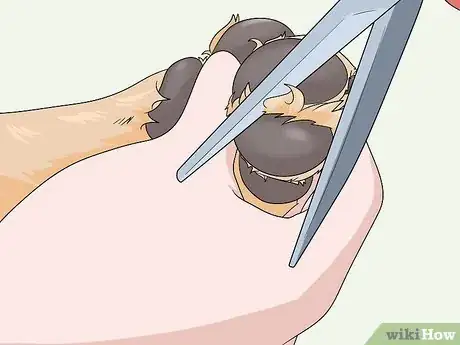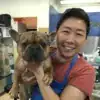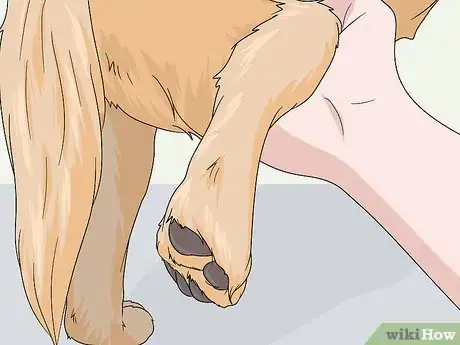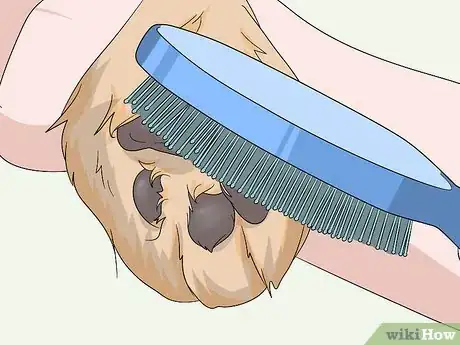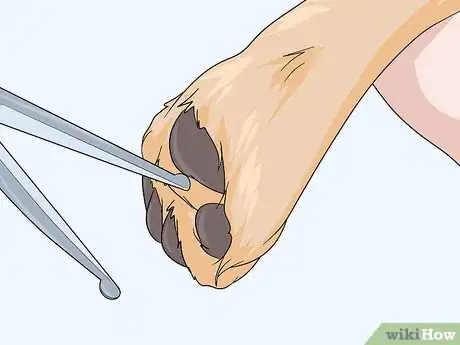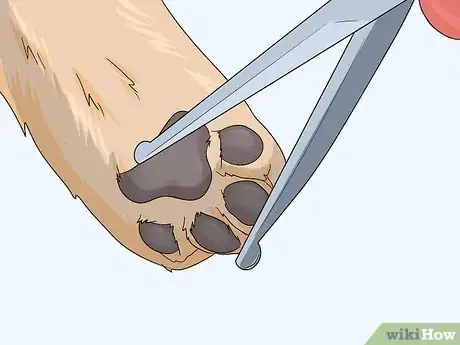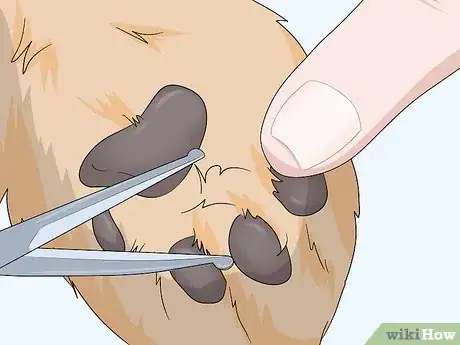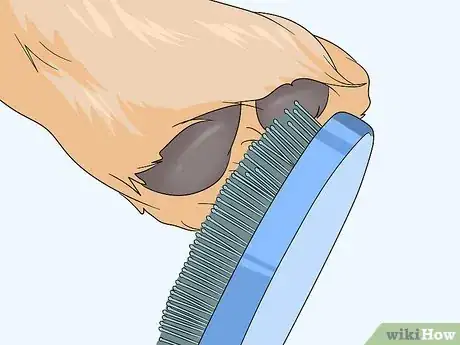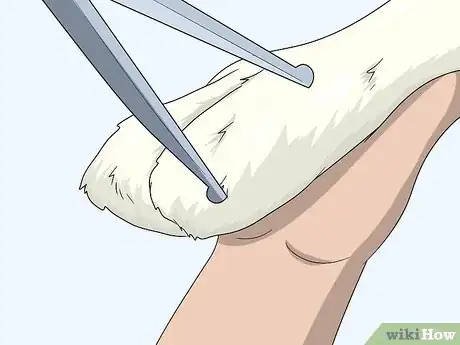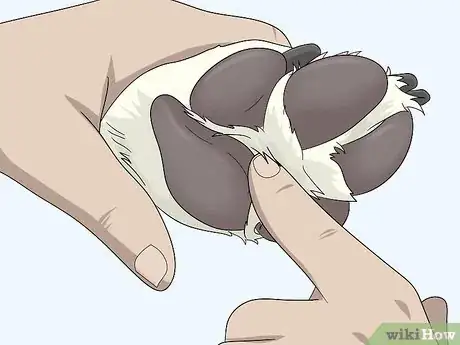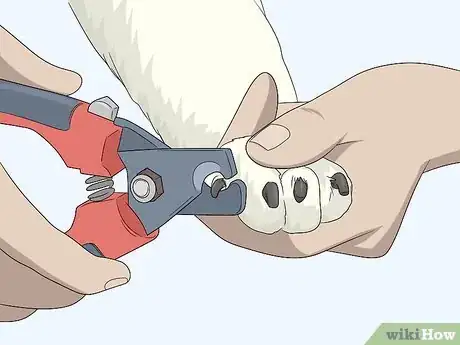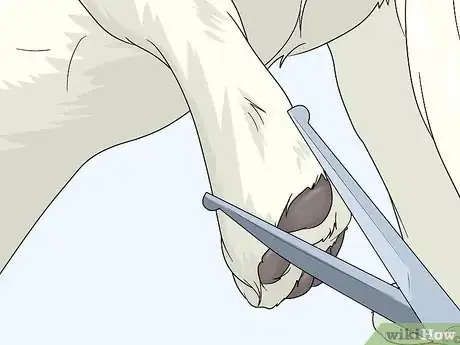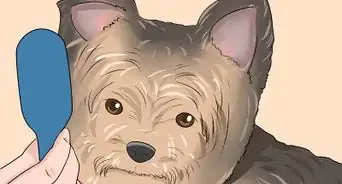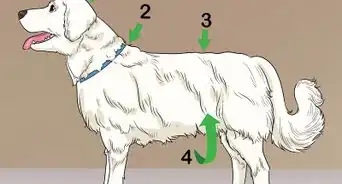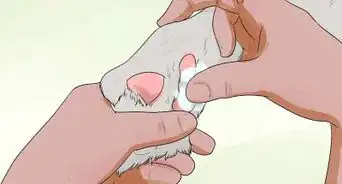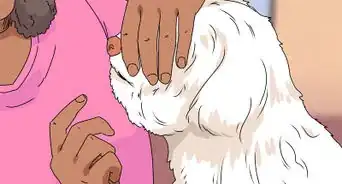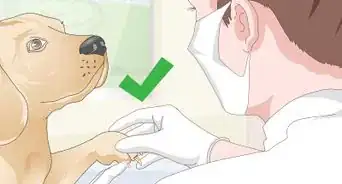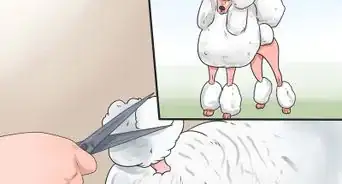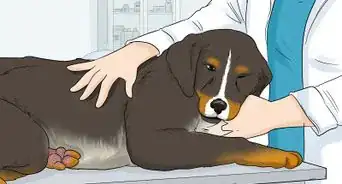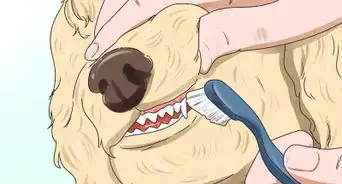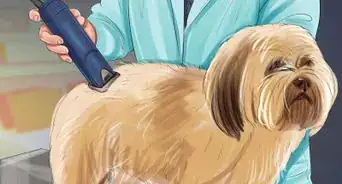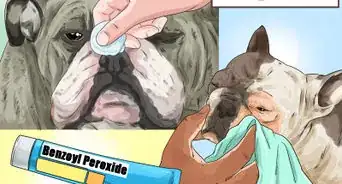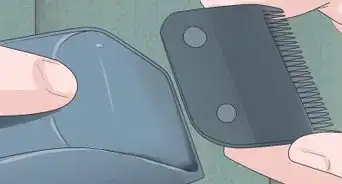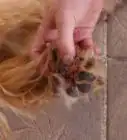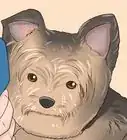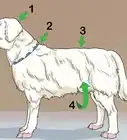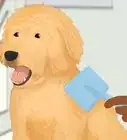This article was co-authored by Lancy Woo and by wikiHow staff writer, Eric McClure. Lancy Woo is a Certified Pet Groomer and the Owner of VIP Grooming, a pet grooming salon based in San Francisco, California. VIP Grooming has served San Francisco for over 35 years. Lancy received her pet grooming certification from the WWPSA (Western Word Pet Supply Association). VIP Grooming has been voted "Best in the Bay" in 2007, 2010, 2011, 2014, 2017, 2018, and 2019 and won Bay Woof’s "Beast of Bay" in 2014. In 2018, Lancy's work contributed to VIP Grooming's acceptance onto San Francisco's Office of Economic and Workforce Development's Legacy Business Registry.
There are 11 references cited in this article, which can be found at the bottom of the page.
This article has been viewed 79,180 times.
When the fur on the bottom of a dog’s foot begins getting in the way of the paw pads, it can be difficult for your dog to move around. The soft paw pads allow your dog to gain traction, grip slick surfaces, and move freely without sliding all over the place. If the fur on the paw grows past the paw pads, it’s time for you to break out the dog-safe scissors and trim the excess hair. While this process isn’t particularly complicated, it is important that you’re careful when trimming around the paw pads, since an open foot wound can lead to an infection. Generally speaking, it’s best to use round-tipped scissors that are designed specifically for dogs to reduce the chance that cut your pet by accident.
Steps
Trimming around the Paw Pads
-
1Cut the paw hair if it’s covering the paw pads or you see them slipping. The fur on your dog’s paws helps to protect their skin. You generally do not need to cut the paw fur unless you notice the fur covering up the paw pads on the bottom of their feet. When this happens, the hair can trip your dog up and cause them to slide around on slicker surfaces. This is a common sign that you need to cut the hair on its feet.[1]
- Short-haired breeds may only need a slight trim once every 2-3 years. Long-haired breeds may require paw trimming every 4-6 months. It really depends on the specific dog breed and the quality of its coat.
- Trim your dog’s paws when it’s in a docile and pleasant mood. If it’s extremely excited or especially agitated, it will be much harder to get it to hold still while you trim its paws.[2]
-
2Grab the first paw up while your dog is standing or lying down. If your dog is standing up, pull the back foot up away from its body and angle it gently towards you. If your dog prefers lying down, roll it onto its back or side to keep its paw raised up and facing you. If it’s on its side and won’t stay on its back, angle the paw up gently towards you.[3] Give your dog lots of praise if it cooperates!
- Don’t forcibly grab and hold your dog. If it becomes distressed or resists when you try to hold its paw, work up to it slowly.[4] First touch your dog on a part of its leg that it’s comfortable with, then gradually work your way closer to its paw. Praise your dog when it accepts your touch. It should get used to having its paws handled over time.
- Do the back feet first. Your dog may nip at you if you start with the front paws and it isn’t in the mood for some grooming, but it’ll likely relax by the time you get to the front paws if you start in the back.
- If your dog loves belly rubs, enlisting a friend to give your pup some gentle pats while you’re trimming is a great way to keep it still.
Tip: Your dog is very likely to lie down or stand up several times while you’re doing this, so you may need to adjust your grip several times over the course of the hair trimming. Always pull your scissors or clippers away from the dog while it’s moving to avoid accidentally cutting it.
Advertisement -
3Raise the hair up with a small, soft-bristled comb. Get a small, soft-bristled brush or comb designed for dog grooming. Hold the paw steady and brush the hair in between the paw pads away from the center of the foot to lift it up. On top of the foot, spread the toes out by hand and brush the hair up towards the ankle. Lifting the hair up makes it much easier to cut any matted hair or clumps of fur that are hiding between the pads and toes.[5]
- The smaller the comb, the easier this will be. At the pet store, look for combs designed for small dogs with fine coats. These tend to be the best option when it comes to combing up the paw hair.
-
4Cut the hair in between the paw pads with small, round-tipped dog scissors. Grab some small, round-tipped scissors designed for dog grooming. Carefully trim the hair sticking out past the paw pads. Start in the center of the foot and work the blades in between each paw pad to cut the excess hair. Work slowly and use your free hand to spread the paw pads out away from the hair that you’re trimming.[6]
- Professional groomers usually use electric clippers to trim the hair between the pads, but it’s much easier to use scissors if you’re doing it yourself. The wide comb on the tip of a shaver is pretty difficult to navigate around the pads if you don’t have any experience.
Warning: Take your time while you do this. It is extremely important that you do not cut a dog’s paw pads. If you do, take your dog to the vet as soon as possible. An incision or cut on a paw pad can lead to an infection.
-
5Trim the hair back until it’s flush with the pads of the paw. Continue cutting the hair in between the paw pads. Trim the exposed hair back far enough so that the fur in between the pads sits flush with surface of the paw pads. It’s important that you don’t remove all of the fur since it protects the dog’s skin when it walks.[7]
- You can tell if the hair in between its pads is cut back far enough by running your finger gently over the surface the paw pads. You’ll be able to feel if the fur ends at the same height as the paw pads.
-
6Lift the hair around the outside of the pads to trim it back. Raise the fur surrounding the exterior side of the paw pads either by hand or with your comb. Trim the hair back with your scissors so that the fur isn’t sticking out past the edges of your dog’s paws. Work in one direction from one corner of the heel, around the nails, and back to the other side of the heel to make sure you trim the entire edge of their foot.[8]
-
7Remove mats, knots, and tangles by brushing or cutting them off. If you find any clumps of knots, mats, or tangled fur, first try brushing the problem area 3-4 times. If you can remove the issue with your comb, cut the hair back the same as the rest of the paw. If the problem can’t be combed out, cut the problematic fur off completely using your scissors or a small set of electric clippers. To use the clippers, turn them on, set them to the lowest power setting, and gently brush the fur you want to cut with the flat edge of the clippers.[9]
- Mats and tangles are particularly problematic when they’re in between the paw pads since they tend to cause pain when they get too big.
- It is better to use an electric clipper for particularly difficult mats. Cutting a really tough mat with scissors may irritate your dog’s skin as the blades tug the hair out of the skin.
Removing Hair from the Toes
-
1Use your scissors to trim the hair on the top of the feet. Flip the dog’s paw over to reach to top of its foot. Use a soft-bristled brush or small comb to brush the hair on top of the paw up. Spread the toes out by pressing gently on the front half of the middle paw pad and brush this hair out as well. Trim the hair in between your dog’s toes using your scissors. If there is a lot of hair on top of the paw, trim it back to your desired length until it’s uniform.[10]
- You have a lot more freedom when it comes to the length of the fur on top of the foot. Unless it’s extremely cold out, you can basically cut this fur to be any length that you want. Generally speaking, the fur on the feet should be uniform with the rest of the fur on the dog’s leg.
-
2Remove any loose hairs that stick out from the paws. Inspect the dog’s paw carefully and look for any individual hairs that you may have missed. Check in between the paw pads again, spread the toes out, and inspect the edges surrounding the foot. Cut any loose hairs off with your scissors.[11]
-
3Trim your dog’s nails after cutting the paw hair if necessary. Since you’re already handling your pup’s feet, now is the perfect to cut your dog’s nails if they need to be trimmed. Grab some dog-safe nail clippers and trim back the front 1⁄4 in (0.64 cm) of the first nail. Only trim the very tip of the nail to avoid cutting into the nerves and blood vessels inside of the dog’s toenail.[12] Repeat this process for every other nail on the paw.[13]
- It’s best if you cut the tip of the nail at a 45° angle towards the back of the paw. This will dramatically decrease the odds that you cut the nerve inside of each nail.
- You really only need to dull the very tip of the nail. Dogs have nerves and blood vessels that run through the center of their toenails and it’s essential that you do not damage them.
- Be extra careful while cutting your dog’s back nails, since it can be very difficult to see the quick (the bundle of nerves and blood vessels) in the rear nails. If you have any doubts, take your dog to a vet or groomer for a trim, or just file the nails down with an emery board.
Warning: If a nail starts bleeding, dip the dog’s paw in some baking soda or cornstarch. This will help stop the bleeding. If the blood won’t stop, wrap the toe in gauze and put a dog boot on the foot. If the blood keeps flowing after 3-5 minutes, take your dog to the vet.
-
4Repeat this process on the other 3 paws. After you’ve trimmed the hair and clipped the nails on the first foot, repeat these steps on the other back paw. Once the back paws are done, do this on the 2 front paws.
Warnings
- For dogs with sensitive feet or pups that resist grooming, it’s much safer to have the paw fur trimmed by a professional. Groomers are used to working with difficult dogs and cutting a paw pad can lead to serious infections and medical issues.[16]⧼thumbs_response⧽
Things You’ll Need
- Towel
- Dog treats
- Dog-safe scissors
- Dog-safe nail trimmer
- Electric clipper
References
- ↑ https://www.aspca.org/pet-care/dog-care/dog-grooming-tips
- ↑ Lancy Woo. Certified Pet Groomer. Expert Interview. 26 February 2020.
- ↑ https://youtu.be/tFZyin5viQ8?t=428
- ↑ Lancy Woo. Certified Pet Groomer. Expert Interview. 26 February 2020.
- ↑ https://youtu.be/mAfltwAd4xM?t=70
- ↑ https://youtu.be/mAfltwAd4xM?t=76
- ↑ https://www.miracleshihtzu.com/trimming-shih-tzu-paw-pads.html
- ↑ https://youtu.be/mAfltwAd4xM?t=93
- ↑ https://www.aspca.org/pet-care/dog-care/dog-grooming-tips
- ↑ https://youtu.be/nfPuaotli6I?t=64
- ↑ https://youtu.be/x72fdEzXMNY?t=59
- ↑ Lancy Woo. Certified Pet Groomer. Expert Interview. 26 February 2020.
- ↑ https://www.petmd.com/dog/slideshows/10-common-paw-problems-dogs
- ↑ https://www.petmd.com/dog/slideshows/10-common-paw-problems-dogs
- ↑ https://www.petmd.com/dog/care/evr_dg_diy-tips-for-grooming-dog-at-home
- ↑ https://www.petmd.com/dog/slideshows/10-common-paw-problems-dogs
